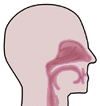  |
||
 |
May 2017Sleep, glymphatic activation and phantosmia inhibitionPhantosmia occurs in about 60% of the many thousands of patients who develop smell loss. It is described as a distorted, unpleasant olfactory sensation in the nose in the absence of any external odor. It can be birhinal or unirhinal. It is usually rotten or chemical in character and overwhelmingly unpleasant. It usually occurs daily, usually spontaneously, lasting for minutes to hours. Patients with unirhinal phantosmia report that after sleep, even for as short as 20 minutes, causes their phantosmia to be inhibited and to disappear. We have studied over 30 patients with this phenomenon. By use of functional magnetic resonance imaging of brain we observed that multiple brain sites, in addition to those mediating olfaction, were activated with phantosmia. By use of magnetic resonance spectroscopy we measured lower than normal brain levels of gamma-aminobutyric acid (GABA) in brain regions in which phantosmia activation occurred. Treatment with GABAergic drugs or with repetitive transcranial magnetic stimulation activated and increased brain GABA which inhibited phantosmia in addition to sleep. Based upon these observations we hypothesize that sleep, even as short as 20 minutes (consistent with phase 2 sleep), through its action in glymphatic activation, activates brain GABA and inhibits phantosmia by reestablishing brain homeostasis. This effect on brain plasticity may be mediated through a complex series of events by which astrocyte activation, which themselves are GABAergic cells, initiate the glymphatic cascade of events, directly activating GABA and GABA receptors and through G-protein coupled activation mediates calcium signaling which thereby inhibits phantosmia. This information was presented at the Experimental Biology 2017 annual meeting in Chicago, IL, April 24, 2017. |
|